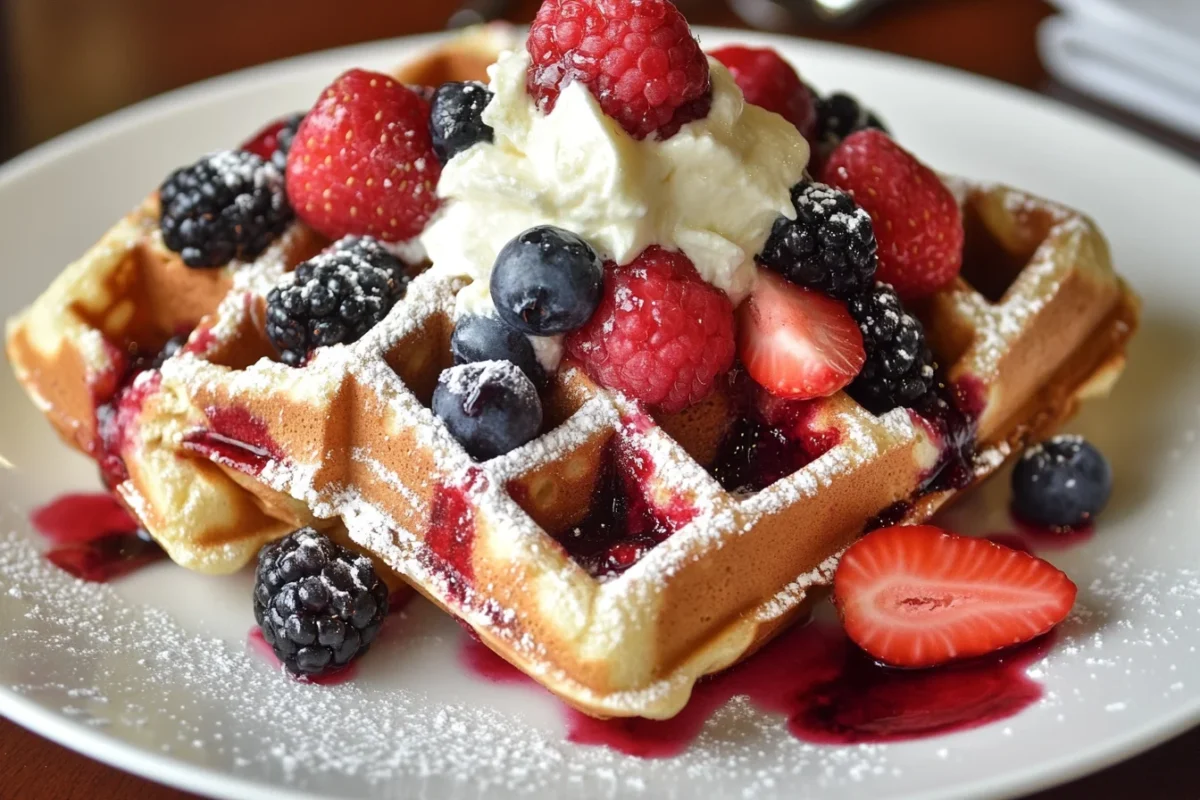Have you ever looked at your jar of sourdough discard and thought, “What can I do with this?” You’re not alone! Sourdough discard waffles are a brilliant and inventive way to turn what seems like waste into golden, crispy breakfast magic. This guide will lead you through everything you need to know, from understanding sourdough discard to mastering the perfect waffle batter, showcasing your resourcefulness and creativity.
In this article, we’ll explore the secrets of sourdough, discard waffles, break down the ingredients, and share cooking tips to ensure your waffles are light, fluffy, and utterly irresistible. We’ll also dive into variations, storage tips, and frequently asked questions to leave no stone unturned. Whether you’re a sourdough novice or a seasoned baker, get ready to unlock the potential of your sourdough starter and discard with confidence!
Table of Contents
What Are Sourdough Discard Waffles?
The Concept of Sourdough Discard
At its core, sourdough discard refers to the portion of sourdough starter you remove before feeding it fresh flour and water. This discarded mixture might seem like a waste, but it’s a treasure trove of tangy flavor and beneficial fermentation properties. Instead of tossing it out, you can use it to create a variety of delightful recipes like pancakes, biscuits, and—of course—crispy sourdough discard waffles. This versatility will inspire you to experiment and be adventurous in your baking.
What’s even better? Using discard helps reduce kitchen waste while adding an extra depth of flavor to your baked goods. Plus, you can enjoy even more delicious recipes using sourdough discard in our dedicated section on SourdoughDiscard.
Why Make Waffles with Sourdough Discard?
You might be wondering, “Why waffles, specifically?” Well, sourdough discard adds an unparalleled tanginess and complexity to waffles that traditional batters can’t replicate. The natural fermentation process also helps break down gluten, making the waffles easier to digest.
Plus, sourdough discard waffles boast that perfect balance—crispy on the outside, fluffy on the inside. And let’s face it, waffles are just plain fun to eat! This fun and enjoyment will make you eager to try this recipe and savor every bite.
Benefits of Using Sourdough Discard in Waffles
Using sourdough discard waffles isn’t just about preventing waste; it comes with a slew of benefits:
- Flavor Boost: The discard introduces a slightly tangy, deep flavor to the waffles.
- Healthier Option: These waffles are easier to digest thanks to fermentation and can even offer improved nutrient absorption.
- No Food Waste: Every bit of your sourdough starter serves a purpose!
Understanding Sourdough Discard
What is Sourdough Discard?
At its simplest, sourdough discard is the portion of the sourdough starter that you remove before feeding it fresh flour and water. This discarded mixture is not “bad” or spoiled—it’s simply an unfed starter. Despite being called “discard,” it’s packed with flavor, natural yeast, and beneficial bacteria, making it a versatile ingredient for many baked goods.
Every time you feed your sourdough starter, you give it a fresh meal to keep it active and bubbly. But without discarding some of the starters first, it would grow uncontrollably, and you’d end up with more starters than you could ever use. That’s where sourdough discard waffles come into play—transforming what could be waste into delicious, golden perfection.
How Sourdough Discard is Collected
Collecting sourdough discard is a straightforward process:
- Daily Feeding Routine: Each time you feed your sourdough starter, remove a portion (usually half).
- Storage: Store the discard in a clean, airtight container in the refrigerator.
- Build Up Over Time: You can keep adding to the container until you have enough for a recipe like sourdough; discard waffles.
Some bakers prefer to keep their discard at room temperature for a few days if they use it quickly, while others opt for refrigeration to slow down fermentation and keep the discard stable.
Difference Between Active Starter and Discard
Understanding the difference between active starter and discard is key to perfecting your waffles:
- Active Starter: Recently fed, bubbly, and ready for baking bread or recipes requiring leavening.
- Discard: Unfed starter, slightly tangy, and best used in recipes where natural yeast activity isn’t required, such as waffles, pancakes, or crackers.
Using discard in waffles is ideal because the leavening power comes from baking powder and baking soda, not from the natural yeast in the starter.
Best Practices for Storing Sourdough Discard
Storing sourdough discard properly is crucial for maintaining its quality and flavor:
- Refrigeration is Best: Store discard in a sealed jar in the fridge for up to two weeks.
- Freeze for Later Use: If you can’t use your discard quickly, freeze it in portioned containers.
- Stir Before Use: Stir it into your waffle batter to reincorporate liquid separation.
Now that you know what sourdough discard is and how to handle it, let’s move on to the fun part—gathering your ingredients and tools!
Ingredients and Equipment for Sourdough Discard Waffles
Essential Ingredients for Sourdough Discard Waffles
Creating the perfect sourdough discard waffles starts with gathering the right ingredients. Each component plays a vital role in texture, flavor, and structure.
- Sourdough Discard: The hero of the recipe, offering tangy flavor and subtle complexity.
- Flour: All-purpose flour is ideal, but you can experiment with whole wheat or gluten-free blends.
- Buttermilk: Adds moisture and a slight tang, complementing the discard beautifully.
- Eggs: Provide structure and richness.
- Butter: Melted butter adds flavor and helps create crispy edges.
- Baking Soda & Baking Powder: These act as leavening agents, ensuring the waffles rise and become light and fluffy.
- Sugar or Honey: Adds a touch of sweetness and helps with browning.
- Vanilla Extract: Optional, but adds warmth and depth to the flavor.
Each ingredient works harmoniously, so avoid skipping or substituting without consideration.
Substitutes and Alternatives
Sometimes, you might not have all the ingredients on hand. Here are some quick substitutes:
- Buttermilk Alternative: Use milk with 1 tablespoon of lemon juice or vinegar.
- Egg Replacement: Try flax eggs (1 tablespoon flaxseed meal + 2.5 tablespoons water).
- Sweetener: Swap sugar for maple syrup or brown sugar for a deeper flavor.
Equipment Checklist
Great waffles require the right tools. Here’s your must-have list:
- Mixing Bowls: These are for combining your ingredients efficiently.
- Measuring Cups and Spoons: Precision matters in waffle batter.
- Whisk: For smooth batter without lumps.
- Waffle Iron: The star of the show. Opt for a high-quality waffle iron for consistently crisp results.
- Spatula or Tongs: This carefully removes waffles without breaking them.
Looking for the best waffle iron? Check out this top-rated waffle iron at Walmart.
Why These Tools Matter
Each tool has a purpose: mixing bowls for easy blending, measuring tools for accuracy, and a waffle iron to deliver that signature crispiness. Skipping any of these might result in uneven cooking or flat waffles.
How to Make Sourdough Discard Waffles
Preparing the Batter (Overnight Fermentation vs. Same-Day Preparation)
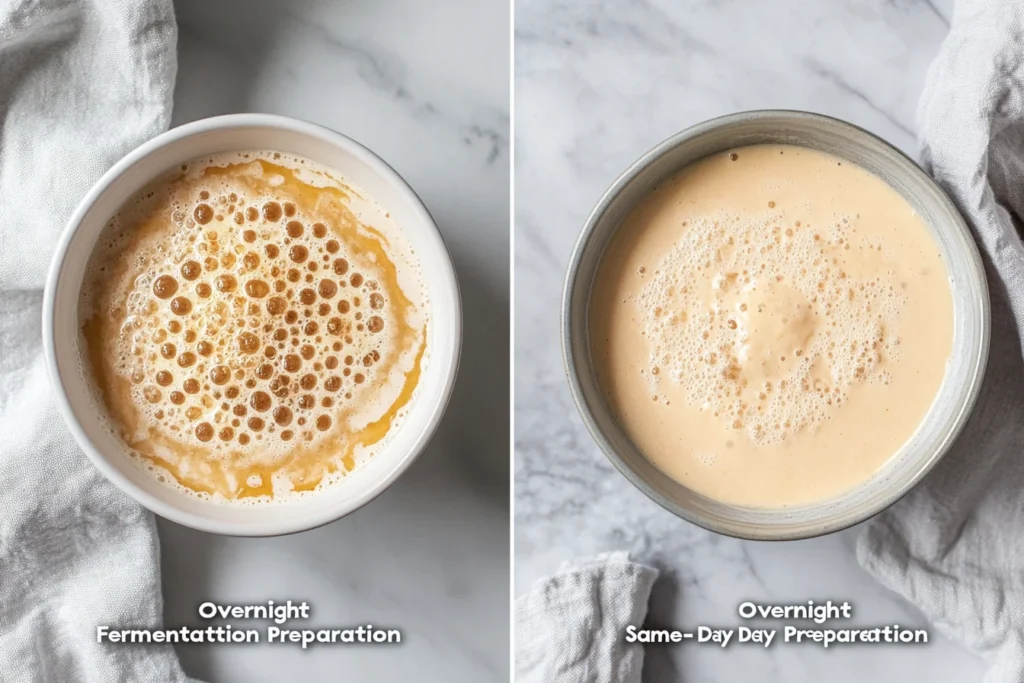
The beauty of sourdough discard waffles lies in their versatility. Whether you prefer the tangy depth of overnight fermentation or a quick morning fix, there’s a method for you.
Overnight Fermentation Method:
- Mix the Base: In a large mixing bowl, whisk together sourdough, discard buttermilk, melted butter, vanilla extract, and flour.
- Rest Overnight: Cover the bowl with a clean kitchen towel or plastic wrap and let it rest at room temperature overnight. It allows fermentation to enhance the flavor and digestibility.
- Add Final Ingredients: In the morning, stir in eggs, baking soda, baking powder, salt, and sugar. Mix gently until just combined.
Same-Day Preparation Method:
- Combine Everything at Once: Mix sourdough, discard, buttermilk, melted butter, eggs, vanilla, sugar, baking soda, baking powder, and flour in one bowl.
- Let It Rest: Allow the batter to sit for about 20 minutes to let the baking soda and powder activate.
No matter which method you choose, avoid overmixing. A few lumps in the batter are OK—they’ll disappear during cooking.
Cooking the Waffles Step-by-Step
- Preheat Your Waffle Iron: Make sure it’s properly heated and lightly greased with cooking spray or melted butter.
- Pour the Batter: Use about ¾ cup for each waffle (adjust based on your waffle iron size).
- Close and Cook: Cook until the steam has stopped chiefly and the waffles are golden brown and crispy (typically 4–6 minutes).
- Remove Carefully: Use a spatula or tongs to lift the waffle out of the iron gently.
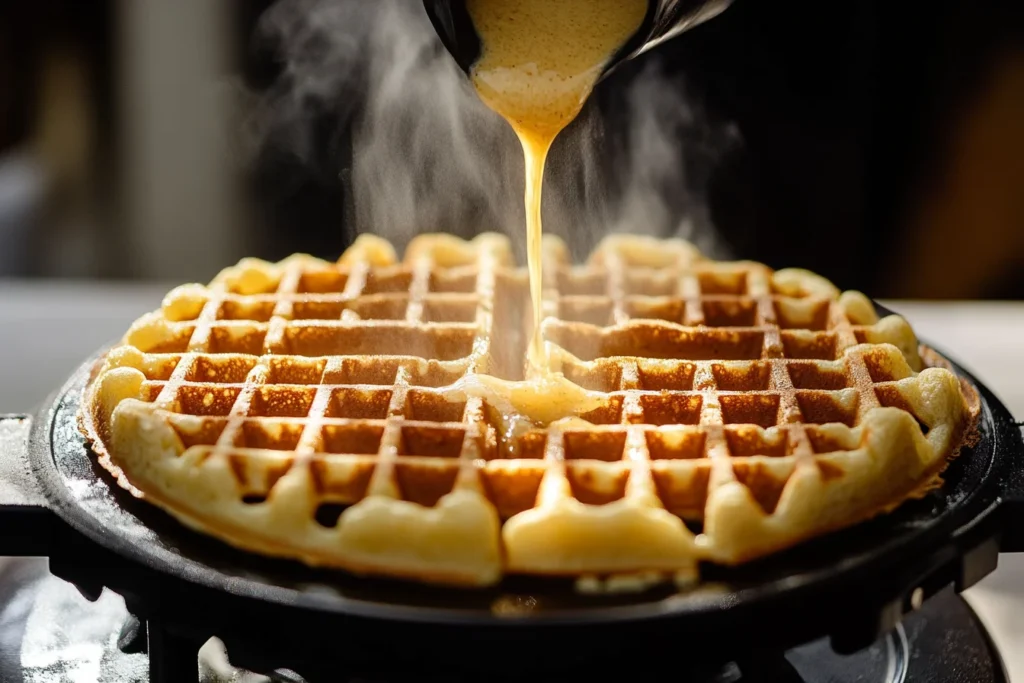
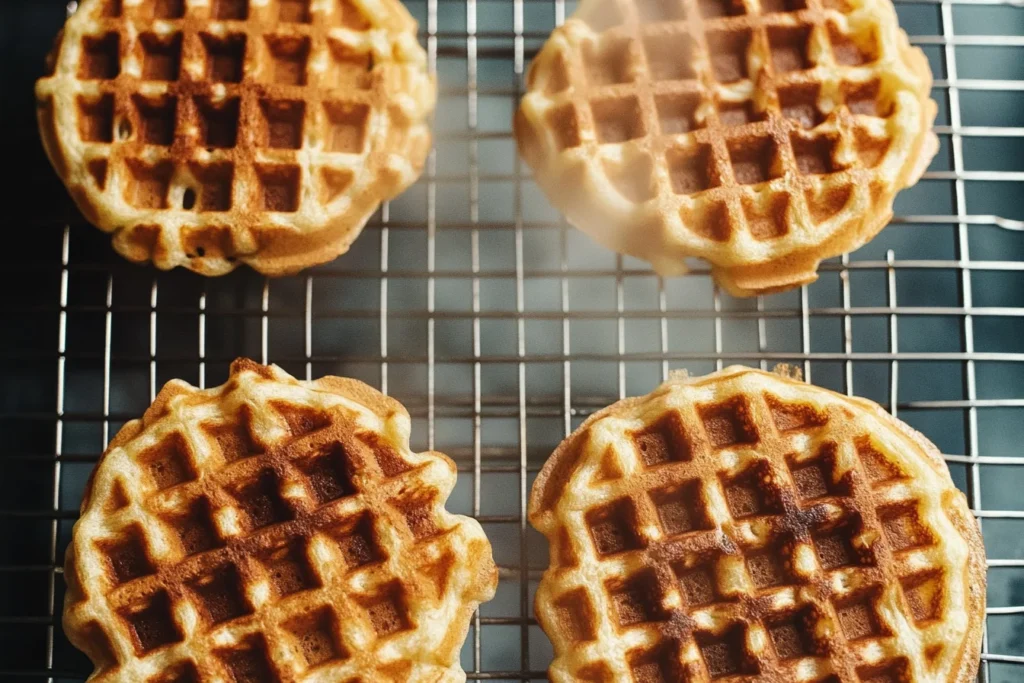
Pro Tip: If you want extra crispy waffles, let them cool on a wire rack instead of stacking.
Troubleshooting Common Issues
- Waffles Are Too Soft: Increase the cooking time slightly or ensure your waffle iron is fully preheated.
- The batter is Too Thin: Add a tablespoon of flour until it reaches the desired consistency.
- Sticking to the Waffle Iron: Ensure your iron is correctly greased before each waffle.
Tips for Perfect Waffles Every Time
- Don’t Skip Resting Time: Resting ensures better texture, Whether overnight or a quick 20 minutes.
- Measure Precisely: Baking is science—stick to the recipe.
- Serve Immediately: Waffles taste best fresh off the iron.
Now that you’ve mastered the batter and cooking process let’s explore how to take these waffles to the next level with creative flavor variations and add-ins!
Creative Variations of Sourdough Discard Waffles
Sweet Variations
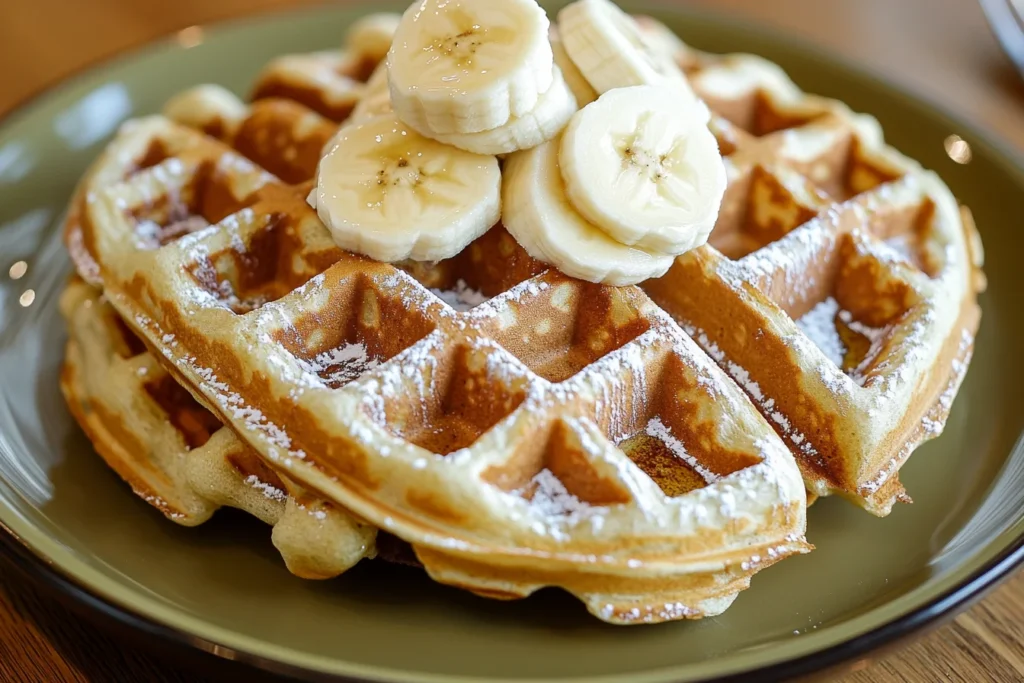
Add a twist to your sourdough discard waffles by incorporating sweet ingredients into the batter:
- Chocolate Chip Waffles: Stir a few chocolate chips for a decadent treat.
- Blueberry Bliss: Fold fresh or frozen blueberries into the batter before cooking.
- Cinnamon Sugar Swirl: Add a teaspoon of cinnamon and a swirl of brown sugar to each waffle.
These additions not only enhance flavor but also make your waffles visually appealing.
Savory Variations
Waffles aren’t just for syrup and powdered sugar—they can be savory delights, too:
- Cheddar and Chive Waffles: Add shredded cheddar cheese and finely chopped chives to the batter.
- Bacon-Infused Waffles: Mix crispy bacon bits directly into the batter.
- Herb & Garlic Waffles: Add minced garlic and fresh herbs like thyme or rosemary.
Savory waffles pair beautifully with fried chicken, poached eggs, or creamy sauces.
Kid-Friendly Add-Ins
Make breakfast fun for the little ones with these playful ideas:
- Sprinkle Waffles: Add colorful sprinkles to the batter for a festive touch.
- Banana Waffles: Mash a ripe banana and mix it into the batter.
- Nutella Drizzle: Serve waffles with a warm Nutella drizzle on top.
These kid-friendly versions are guaranteed to bring smiles to the breakfast table!
Gluten-Free or Dairy-Free Adaptations
Dietary restrictions? No problem!
- Gluten-Free Flour: Substitute all-purpose flour with a gluten-free blend.
- Dairy-Free Buttermilk: Use almond milk with a splash of lemon juice.
- Egg Substitute: Replace eggs with flax eggs (1 tablespoon flaxseed meal + 2.5 tablespoons water).
What to Serve with Sourdough Discard Waffles
Classic Toppings
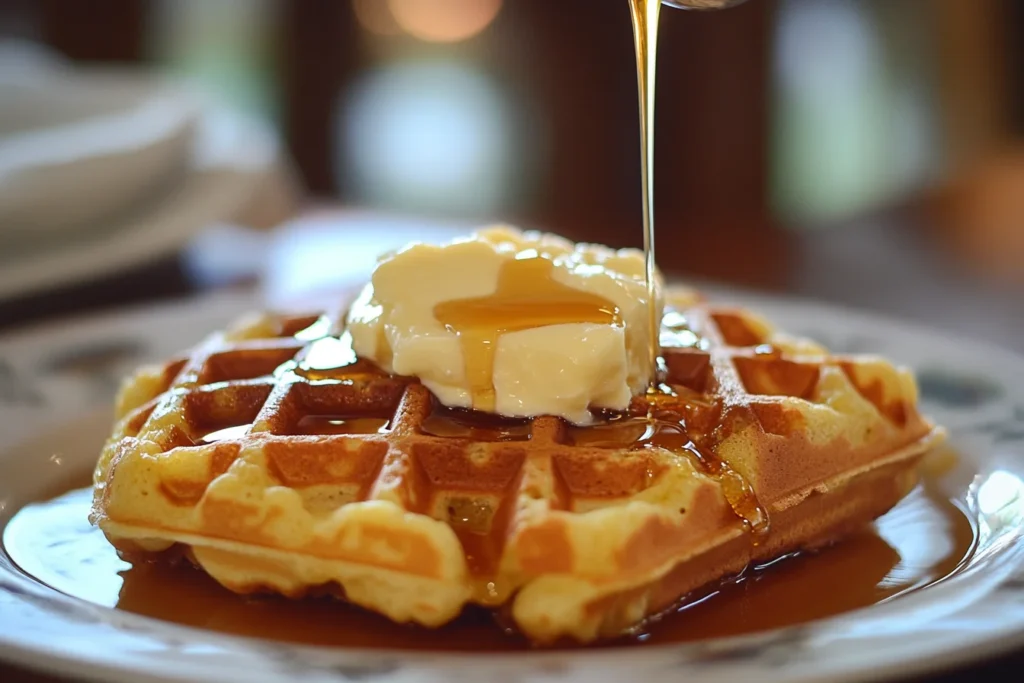
Regarding sourdough, discard waffles; classic toppings never go out of style. These timeless choices perfectly complement the tangy richness of the waffles:
- Pure Maple Syrup: A golden drizzle of real maple syrup is a must.
- Whipped Cream: Soft, airy cream adds a luxurious texture.
- Fresh Berries: Blueberries, strawberries, or raspberries provide freshness.
- Powdered Sugar: A light dusting of powdered sugar enhances flavor and presentation.
Pair these waffles with a steaming cup of coffee or freshly squeezed orange juice for a nostalgic breakfast.
Breakfast Pairings
Take your sourdough discard waffles from good to unforgettable with these breakfast accompaniments:
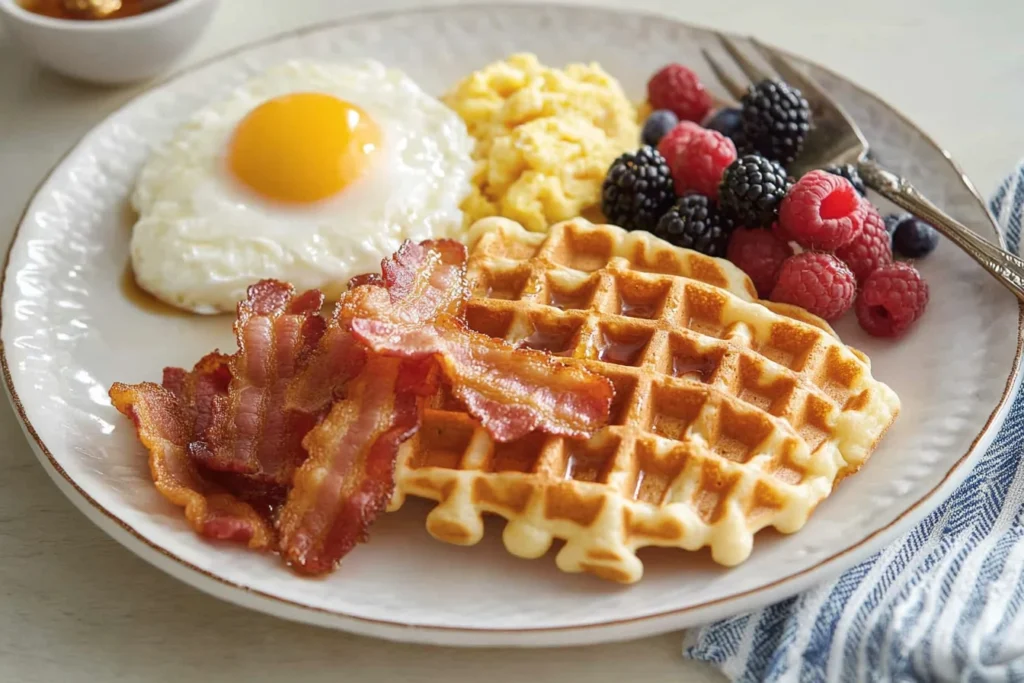
- Crispy Bacon: The smoky, salty crunch of bacon pairs perfectly with sweet waffles.
- Scrambled Eggs: A creamy serving of scrambled eggs balances the crispy texture of waffles.
- Sausage Links: Juicy sausage adds a savory depth to the meal.
- Greek Yogurt: Serve waffles with tangy yogurt for a healthier twist.
Consider creating a waffle board with these pairings arranged artfully on a large platter for a restaurant-style brunch.
Creative Serving Ideas
Why stop at breakfast? Sourdough discard waffles are versatile enough for any meal:
- Waffle Sandwich: Use waffles as bread for a fried chicken sandwich.
- Ice Cream Waffles: Top with a scoop of vanilla ice cream and chocolate drizzle.
- Savory Waffle Stack: Layer waffles with grilled chicken, cheese, and a creamy sauce.
These ideas push waffles beyond breakfast territory and into the spotlight of creative dining.
How to Store and Reheat Leftovers
Nobody likes soggy waffles, so proper storage and reheating are essential:
- Storing Leftovers: Place cooled waffles in an airtight container. They’ll stay fresh in the refrigerator for up to 5 days.
- Freezing Waffles: Layer waffles between parchment paper and freeze them in a ziplock bag for up to 3 months.
- Reheating Waffles:
- Oven: Bake at 350°F (175°C) for 10 minutes.
- Toaster: Pop them straight into the toaster for crispy edges.
Avoid microwaving waffles—they tend to become soft and lose their crispiness.
Are Sourdough Discard Waffles Healthy?
Nutritional Breakdown
While sourdough discard waffles are undoubtedly indulgent, they can also offer some nutritional benefits thanks to the sourdough fermentation process. Here’s a rough breakdown per waffle:
- Calories: Approximately 300–400 kcal (depending on toppings).
- Protein: Around 8–10g per serving.
- Carbohydrates: Roughly 40–50g per waffle.
- Fats: About 12–15g from butter and eggs.
These waffles balance indulgence and nutritional value, especially when paired with wholesome toppings.
Benefits of Fermented Grains in Waffles
Fermented grains, like those in sourdough discard waffles, have several health advantages:
- Improved Digestibility: Fermentation breaks down gluten, making it easier on the stomach.
- Enhanced Nutrient Absorption: Nutrients like iron, zinc, and magnesium are more bioavailable after fermentation.
- Balanced Blood Sugar Levels: The fermentation process may help reduce the glycemic index of the waffles.
When made with high-quality ingredients and balanced toppings, these waffles can be part of a healthy breakfast.
Tips for Making Healthier Waffles
Want to make your sourdough discard waffles even healthier? Here are a few tips:
- Use Whole Wheat Flour: Swap half or all of the flour for whole wheat.
- Reduce Sugar: Cut the sugar in half or use natural sweeteners like honey or maple syrup.
- Add Nutrient Boosters: Mix chia seeds, flaxseed, or protein powder.
- Top Smartly: Choose Greek yogurt, fresh fruit, or nut butter instead of syrup.
Mistakes to Avoid When Making Sourdough Discard Waffles
Overmixing the Batter
One of the most common mistakes when making sourdough discard waffles is overmixing the batter. While it might feel satisfying to stir until smooth, doing so develops too much gluten, resulting in dense and chewy waffles instead of light and fluffy ones.
Solution: Mix the batter gently until the dry and wet ingredients are incorporated. A few small lumps are perfectly fine—they’ll disappear during cooking.
Incorrect Fermentation Time
Getting the fermentation timing wrong can affect both flavor and texture. If the batter ferments too long, it may become overly sour and lose structure. On the flip side, skipping fermentation can result in underwhelming flavor.
Solution: For an overnight fermentation, let the batter rest at room temperature for 8–12 hours. If you’re making same-day waffles, allow the batter to sit for at least 20 minutes before cooking.
Not Preheating the Waffle Iron
A cold waffle iron is a recipe for disaster. Without proper preheating, your waffles may cook unevenly, stick to the plates, or lack that signature crispy exterior.
Solution: Always preheat your waffle iron fully before pouring in the batter. Most waffle makers have an indicator light—wait for it to turn on before cooking.
Using Old or Expired Sourdough Discard
While sourdough discard can last for weeks in the refrigerator, it does have its limits. Discard that smells rancid or has visible mold should never be used.
Solution: Always store discarded in a sealed container in the fridge and check it before use. Fresh discard ensures better flavor and safety.
Skipping the Resting Time After Mixing
If you’re rushing and skip the resting time after mixing the batter, your waffles might not rise properly or have the ideal texture.
Solution: Even if you’re not fermenting overnight, let the batter rest for at least 20 minutes before cooking. It allows the leavening agents to activate and the batter to relax.
Pouring Too Much Batter Into the Waffle Iron
Filling every inch of the waffle iron with batter is tempting, but overfilling leads to spillage, uneven cooking, and a sticky mess.
Solution: Pour just enough batter to cover the waffle iron’s grid, usually around ¾ cup, depending on the size of your waffle iron.
By avoiding these common mistakes, you’ll ensure your sourdough discard waffles are light, crispy, and packed with flavor every time.
Frequently Asked Questions About Sourdough Discard Waffles
Can I use an active starter instead of a discard?
Absolutely! While sourdough discard is typically used because it’s an unfed byproduct, an active starter can also work. Remember that an active starter may increase the waffles, slightly altering the texture.
Can I freeze sourdough waffles?
You can freeze sourdough and discard waffles for up to 3 months. Place them in a single layer on a baking sheet, freeze them until solid, and then transfer them to a freezer-safe bag. Reheat in the toaster or oven for best results.
Why are my waffles not crispy?
If your waffles lack crispiness, it’s likely due to undercooking or an improperly preheated waffle iron. Let the waffles cook until steam stops escaping, and avoid stacking them on a plate—they’ll turn soggy from trapped steam.
What’s the best way to reheat waffles?
For crispy waffles, the best reheating methods are:
Toaster Oven: Toast for 3–5 minutes at 350°F (175°C).
Oven: Bake at 350°F (175°C) for 10 minutes.
Avoid using the microwave, as it can make waffles rubbery.

